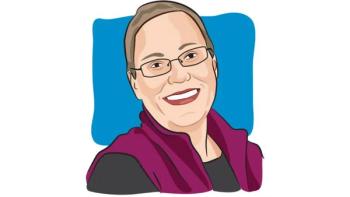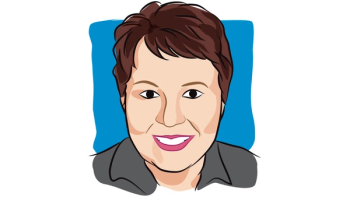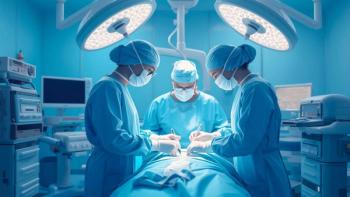
- Special Issue 2007
- Volume 6
- Issue 3
To Catch a Cancer
Patients benefit from ease and success of modern breast cancer screening.
Earlier this year Andrea Barish learned how new high-tech tools are supplementing an old one—mammography, still the screening method of choice—in detecting and diagnosing breast cancer.
Barish, 45, strategic director of communications for Northern California at the American Cancer Society’s office in Oakland, underwent surgery in 2006 for removal of an early-stage invasive ductal carcinoma in her left breast, followed by radiation and chemotherapy. The centerpiece of her follow-up screening in February 2007 in San Francisco was digital, rather than film, mamography.
Digital mammography captures X-ray images in computer code instead of on X-ray film, enabling the operator to adjust an image’s magnification, orientation, brightness and contrast to get a clearer view. Unlike its film counterpart, the digital device entails lower radiation doses and virtually no wait for results.
“It was very interesting,” Barish says. “One of the things I wasn’t quite prepared for was that they were able to give me my results immediately.” She says not having to wait anxiously for the film to be developed and read, and for the findings to arrive days later on a postcard, brought her some comfort but also meant she might have to contend with distressing news that same day. Fortunately, the digital mammogram did not detect signs of recurrent disease.
One of the things I wasn't quite prepared for [with digital mammography] was that they were able to give me my results immediately.
The goal of screening is not only to find more cancers, but to have that result in improved survival for those patients. Experts attribute declines in breast cancer deaths since 1990 to a combination of early detection, with the aid of tools like mammography, and better therapies. Statistics show mammograms reduce such deaths by 20 to 35 percent in women between ages 50 and 69, and by about 20 percent in women in their 40s. The American Cancer Society now recommends women undergo annual mammograms beginning at age 40 (the previous recommendation was every year or two for ages 40 to 49) because earlier detection means a greater chance of survival and more treatment options.
Clinicians are turning to state-of-the-art tools and techniques, or combinations of them, to supplement mammography and in some cases ease the impact of procedures on patients. Although mammography remains the only widely accepted (and most widely available) imaging method for routine breast cancer screening, various other techniques may be used.
In addition to improving the quality of images the radiologist sees and, as Barish discovered, speeding the whole screening process, a study of about 50,000 women, published in the New England Journal of Medicine in 2005, suggested another potential advantage. Although overall diagnostic accuracy of the two screening techniques was similar, investigators reported that digital mammography was more accurate than film mammography as a screening tool for women with dense breasts, those younger than 50 and who are premenopausal or perimenopausal.
Often‚ digital mammography is paired with sophisticated software that can bring suspicious areas to the radiologist’s attention. CAD‚ or computer-aided detection‚ is pattern-recognition software that can flag suspicious lesions the radiologist may have overlooked and that might warrant examination. It leverages the notion that computer knowledge tends to be more consistent than human knowledge in analyzing an image, says Gary Whitman, MD, a radiologist at M.D. Anderson Cancer Center in Houston.
“Maybe one day the radiologist is distracted or just not focusing, and performance drops off a bit,” he says. “With the computer, performance should be relatively constant.” However, a new study published in NEJM in April found that use of CAD did not clearly improve the detection of breast cancer and may instead make readings less accurate, leading to a higher number of false positives.
This technique involves removing a tissue sample with a hollow needle instead of surgically, which entails greater risk, discomfort and scarring. Minimally invasive biopsies, such as fine needle aspiration (FNA), core biopsy and vacuum-assisted biopsy, are commonly used and have the potential to spare up to 80 percent of women who otherwise might undergo open breast biopsy.
Danene Birtell has seen the payoffs of minimally invasive biopsy firsthand. Daunting aspects of two surgeries back in 1998 and 2001—preoperative blood work, general anesthesia, scalpel cuts and sutures—to excise a suspicious growth from her right and then her left breast after core biopsies seem almost quaint now.
That’s because in 2006, the 31-year-old veterinary nurse from Yardley, Pennsylvania, had a third growth removed as an outpatient by means of a vacuum-assisted biopsy. After a small incision and under local anesthesia, the doctor pinpointed and removed the growth from surrounding tissue through a pencil-sized needle. Doctors can withdraw larger segments of tissue with vacuumassisted biopsy than with FNA or core biopsy.
In all three instances, the growths proved to be benign fibroadenomas. But the third time, Birtell could watch the entire procedure on a nearby monitor while interacting with the surgeon. Closure of the quarter-inch surgical cut with tape strips rather than traditional sutures contributed to her quick recovery, despite some minor bruising. She even attended kick-boxing camp in Oregon the following week.
“I think the development of this procedure is just great,” Birtell says. “The less [surgery], the better.”
Echoes from sound waves bounce off tissues and organs, producing distinct images. Ultrasound, or sonogram, can distinguish between solid masses and fluid-filled cysts, assess lumps that are difficult to see or inconclusive on a mammogram, or guide a surgeon’s instrument to a precise location during biopsy.
“The quality of the ultrasound image has improved, which makes it easier to put the [biopsy] needle in the right place and to see lumps that are a bit smaller than we used to be able to see—and see them accurately,” says Jack Meyer, MD, a radiologist at Dana-Farber Cancer Institute and Brigham and Women’s Hospital in Boston. Studies are ongoing to see if ultrasound can be useful as a screening tool in addition to simply focusing on abnormalities picked up on physical examination or mammogram.
What's been exciting is that we’ve discovered MRI can detect cancers invisible on mammography, on ultrasound and on clinical breast exam.
A magnet linked to a computer yields detailed, threedimensional images of tissue—enhanced by an intravenous contrast agent—without the radiation exposure that comes with X-ray mammography.
MRI is versatile. Among other uses, it can investigate suspicious findings on mammogram images, which are only two-dimensional; investigate abnormal tissue that is felt but not visible on a mammogram or ultrasound; assess the extent of diagnosed disease; and potentially find cancer that mammography overlooked in the dense breasts of younger women, especially those at high genetic risk.
“What’s been exciting is that we’ve discovered MRI can detect cancers invisible on mammography, on ultrasound and on clinical breast exam,” says Constance Lehman, MD, PhD, director of breast imaging at the Seattle Cancer Care Alliance. Breast MRI remains a difficult examination to perform and interpret well, say experts, and requires highly experienced breast MRI clinicians. In addition, MRI is currently used primarily in very high-risk situations, such as individuals with a genetic predisposition—specifically, mutations in the BRCA1 or BRCA2 genes.
The American Cancer Society published new guidelines in March for breast screening MRI to include women with a BRCA1 or BRCA2 mutation (the inherited gene mutations that carry a high risk of breast cancer), a strong family history of breast or ovarian cancer, a 20 percent or greater lifetime risk of breast cancer and who had radiation therapy to the chest for treatment of Hodgkin’s disease.
PET scans are more accurate in finding large, aggressive growths. Since tumor tissue uses more glucose than normal breast tissue‚ PET scanning detects tumors by determining sugar absorption in breast tissue. Clinicians may also use PET to gauge the extent of disease—though the test may not be completely accurate—and to monitor tumor shrinkage after treatment.
At first glance, breast cancer may appear no match against this impressive arsenal. But, as clinicians are quick to point out, no individual tool is appropriate for detecting all types of breast cancer. And each has strengths and weaknesses— including high cost and, in some instances, false positives (results that initially suggest cancer but in fact are benign, leading to needless anxiety for patients and unnecessary surgery).
Take ultrasound, for example. While ultrasound is “very powerful,” its sensitivity—the proportion of true positives it finds—in detecting breast cancer isn’t as high as with MRI, says Dr. Lehman. High sensitivity may mean MRI is particularly appropriate for high-risk women who are genetically predisposed for breast cancer.
Investigators reported in NEJM in March that MRIs in women who were diagnosed with cancer in one breast detected more than 90 percent of cancers in the other breast that were missed by mammography and clinical exam at initial diagnosis. “We found that when we add screening MRI to the screening mammography program, we can significantly increase the number of cancers we find in this group,” says Dr. Lehman, who served as principal investigator of the study. “It’s very exciting.”
The long-term hope of MRI’s ability to predict absence of a tumor, say researchers, is to reduce the number of unnecessary double, or bilateral, mastectomies at initial diagnosis. On the other hand, the heightened sensitivity that makes MRI so valuable can result in low specificity—a high rate of false positives. That may mean MRI is less appropriate for lower-risk women, and experts caution MRI should not be substituted for mammography.
The future holds promise for even newer technologies and for refinement of those available now. For example, researchers hope biomarkers—molecular or cellular indicators of susceptibility to or the presence of disease—will one day prove effective in detecting breast cancer earlier, perhaps in combination with other screening methods. BRCA1 and BRCA2 serve as biomarkers. The goal is to identify other cancer susceptibility genes and blood-borne indicators that would reliably aid detection in much larger populations, says Jeffrey Marks, PhD, an associate professor of surgery at Duke University Medical Center in Durham, North Carolina, who is studying the molecular biology and genetics of breast cancer.
To be of clinical value, he says, new biomarkers must demonstrate higher sensitivity and specificity than mammography—that is, generate fewer false negatives and false positives—or somehow work in tandem with mammography. Marks’s research focuses on creating a so-called library of antibodies for breast cancer-secreted glycoproteins that, in conjunction with mammography, could be applied to help discriminate between cancerous and benign findings.
However, such breast cancer assays are years away, says Marks.“There’s no shortage of biomarkers that have been proposed, but none of them have very good performance in real-life specimens.”
While biomarker research may not produce immediate screening payoffs, it along with refined technologies like digital mammography are expected to lead clinicians closer to a common goal: earlier detection of breast cancer that translates into more patients living longer.
Articles in this issue
over 18 years ago
Screening for Recurrent Breast Cancerover 18 years ago
A New Eraover 18 years ago
The Comforts of Helpover 18 years ago
Eluding Cancerover 18 years ago
Navigation As Supportover 18 years ago
The Lifestyle Approachover 18 years ago
The Law of Distractionover 18 years ago
What Stage Is Your Breast Cancer?over 18 years ago
Optimism for Inflammatory Breast Cancerover 18 years ago
Message from the Editor




